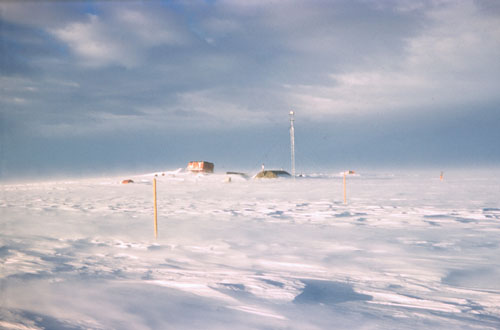Site 2 (S2) Glaciology Station
- S2 Photos from 1957 by Olav H. Loken
- Trip to S2 Trip to S2, April 6, 1958 By Seb Borrello
- Trip to S2 in 96/97 by Darryn Schneider
- Photos from a trip to S2 in 96/97
The International Geophysical Year (IGY) was a world wide investigation of the earth, ranging from the solid earth, through the atmosphere, and all the way out to space. The research was conducted by many nations cooperating in an unprecedented way. Crucial to the success of the IGY was gathering data in the polar regions, and to this end bases were set up in Antarctica. Working in Antarctica presents logistical hurdles not normally encountered in science, and many nations looked to their defense forces to provide logistical support, and in the case of the US, the navy was the obvious choice with their icebreakers and experience in polar regions.
One of the key sciences during the IGY was glaciology, and to this end the Wilkes winter crew included a team of three glaciologists, Olav Loken, John Molholm, and led by Richard Cameron. One of their key objectives was setting up a glaciology research sub-base on the polar ice cap. While Wilkes was being constructed, a short excursion onto the plateau was undertaken, and the trail was marked and nicknamed the Sullivan Trail. On February 22 the glaciologist followed the Sullivan Trail about 10km from Wilkes up onto the edge of the plateau and set up a meteorological shelter, called Site-1. On March 11 Operation Crampon (Cameron, Loken, Molholm, Eklund, Honkala, and Noonan) set out along the Sullivan trail,past Site-1, with the goal of setting up the glaciology sub-base. The location was to be "well above the equilibrium line where we could expect to find the annual firn layers preserved in the stratigraphy" and for safety and logistical reasons within a days travel for a heavily loaded Weasel.
After 11 hours of travel from Wilkes, during which time the slope had been gradually leveling off, until the terrain was close to flat, Dick Cameron announcing "This is the place". The new sub-base called Site-2 (S2 for short) was located 85km from Wilkes and 1300m above sea level. Straight away the team set up a Jamesway hut, a weather station, a large grid of surface stakes to measure snow accumulation and horizontal ice deformation, and they started a pit which would eventually extend hundreds of years back in the ice record. However for now it was just a start and the team headed back to Wilkes.
The glaciology team was back at S2 on April 25, and Dick Cameron and John Molholm continued the excavation of a deep pit to investigate the accumulation of snow on the ice cap. Over the next few months, with members of the Wilkes crew regularly relieving the S2 crew, a pit 2m square was dug down 115 feet, back through 175 years of accumulated snow, to snow laid down in the year 1783. The pit was excavated by hand with pick ax, with snow and ice hauled out with a wooden box named the Berk. Olav Loken recalls "After we no longer were able to throw out by hand the 'debris' we picked out from the bottom of the pit, we turned to the 'Berk' until that was filled and then pulled it to the surface with a weasel and emptied it before starting over again. I don't remember how the plywood box got its name, but it stems from Berkely - the easygoing and popular geomagnetism member of our crew. The digging at the bottom was accomplishd by using a regular pick ax to break out the firn and than a showel to fill the 'Berk'. The space at the bottom was restricted to the 2x2m cross section of the pit, so there was not much 'elbove room'. But we managed. At least we were out of the cold winds! I recall we typically worked in a t-shirts. Every now and then, we got a break, when we stopped so that Dick C. could complete his stratigraphic recordings." "Near the bottom of the shaft, we dug a short horizontal 'stall' for the installation of dials, that we - or our successors - could measure deformation over time. This complemented a large polygon of ablation stakes on the surface, with S2 at one corner that measured horizontal strain rates." A 85 foot deep bore hole was later drilled at the bottom of the pit, reaching a total depth of 200 feet.
On January 22nd, 1958 S2 was closed down for crew change-over at Wilkes after being continuously manned since April, producing along with the glaciological results, and an unbroken meteorological record for this period. Site-2 would be soon re-occupied by the 1958 crew, and studies would continue there for many years.
Information about Site-2 from Gil Dewart's "Journey to the Ice Age" and correspondence with Olav Loken.

Diagram of S2 from an old Station Year Book.

S-2 during the 1957 winter. Winter 1957, by Olav Loken.

